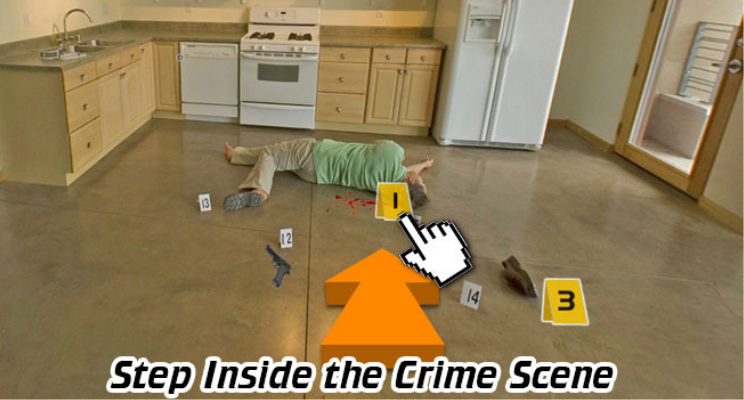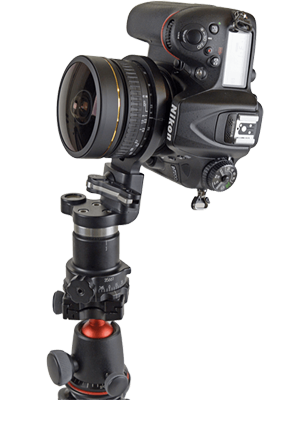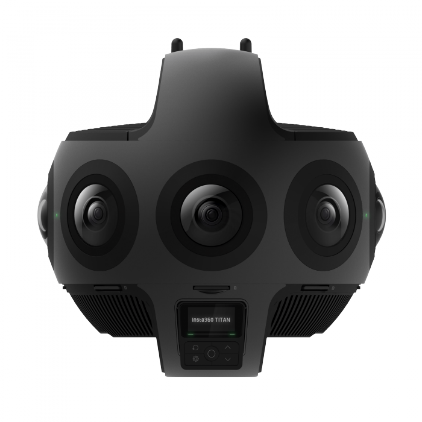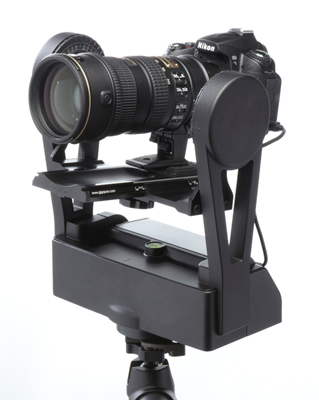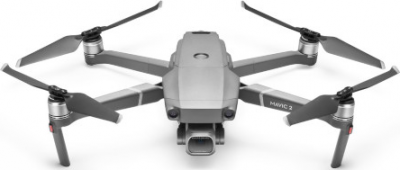360 Virtual Tours in Crime Scene Investigation
If you’ve viewed any recent real estate listings, you will notice an increasing number of virtual tours included among the usual series of still shots and slick videos. They are in most cases professionally produced and help the property stand from all the others.
If you are not familiar with virtual tours, they are a series of 360° images linked together simulating a self-guided walkthrough of a real estate listing from the confines of your web browser. These applications let you move freely move around the image using your cursor or by rotating your mobile device. For instance, you may be looking at a living room pointed towards the fireplace. By scrolling left or right on the image, you would be able to rotate around the room until you arrive back at the starting point. You would also be able to scroll up and look at the ceiling or look down to check out the hardwood. Connecting to and navigating through the other 360° images in the tour creates the virtual experience of standing and walking through the property itself.
Based on ‘spherical’ photography, multiple images of a space are captured with a digital camera. Using specialized software, each individual image is digitally stitched together into a ‘spherical ‘orientation (think of the night sky projected onto the ceiling of the planetarium). When viewed over a web browser, another software application needs to correct the spherical image so that it can be viewed interactively on a 2D screen. All of these individual elements play an essential part in creating the illusion of being inside the picture whether viewed on a flatscreen or through a VR headset.
This technology was first pioneered in real estate during the 90s and has seen gradual adoption into other industries including public sector. As the underlying technologies have evolved, we have witnessed growing applications of virtual imagery in law enforcement, occupational health and safety as well as safeguarding the public interest.
This series of articles will dive into how these modern imaging technologies are finding their place within public sector.
In Crime Scene Investigation
It may seem intuitive and obvious why 360° imagery is used in Crime Scene Investigations, but let’s look at and break down the key benefits of these technologies as it relates enhancing the investigation and ultimately solving crime.
Once an investigation team arrives onto a serious crime scene, evidence collection begins. Photographs of the space are captured in mass volume and each relevant pieces of evidence is photographed in detail. Traditionally, investigators try to piece together these image fragments to get a sense of and portray the crime scene as best they can.
A single continuous panorama can capture a highly detailed image of an entire scene with a single pass reducing the volume of individual images required for the investigation, while capturing minute details that may have been overlooked. This minimizes the number of investigators on-site further reducing extraneous contamination of the scene while expediting the investigation process itself.
Off-Site Analysis
Unlike the TV portrayal, there are a minimal number of personnel on any given crime scene. Each investigator is typically covered from head to toe in a hazmat suit. Any additional DNA in the form of skin cells, extraneous fibers, or organic material may be enough to cast doubt on any precious piece of evidence and having it thrown out of court.
Virtual image platforms such as CSI 360 from VPiX offer both online and offline access in a highly secured environment. Having these interactive images of the scene allows for detailed visual analysis at any time of day on any device, long after the crime scene tape is taken down.
Connect Evidence
By linking digitized evidence in the form of photos, video, and audio to the virtual crime scene, the virtual scene serves as a visual database for the case in question. Accessible as a virtual walkthrough, the platform vastly improves and organizes the complexities of the investigation by connecting crucial and relevant evidence and presenting them in meaningful and compelling ways.
Ability to Share & Collaborate
Based on its powerful server technology CSI 360 can host multiple investigators and specialists simultaneously Accessible from any device or locations , each team member can remotely view, annotate or add evidence to the scene in real-time. With the power of collaborative analysis, the investigation can progress with much greater speed and efficiency.
Empowering the Prosecution
The power of Virtual Reality was first used in the courtroom in the case of Stephenson vs. Honda Motor Corporation (Honda) back in 1992. Honda, the defendant, produced an animated VR reconstruction of a motorcycle accident. The presentation placed the jurors in a virtual reconstruction of the crash scene from the Honda’s perspective. So compelling was this portrayal, the case was successfully awarded to Honda.
Without the means of Honda Motor Corporation, many state and local agencies rely on CSI 360 to quickly and efficiently develop, organize and present virtual reconstructions of complex and serious crimes. They are able to create self-contained virtual walkthroughs of the crime and present these cases interactively on screen or through VR headsets in the courtroom.
CSI 360 can leverage existing photographic equipment, while the cost to own and maintain the software is well within the operating budget of a local police department.
The workflow is simple and efficient and a small forensics team can be trained on the entire CSI 360 platform in less than 1 day.
Background
The concept of 360° photography has been around since the birth of photography itself. The earliest forms of 360° panoramas were constructed with a set of images taken from a camera that was rotated around a fixed position. Once developed the individual images were assembled in series and then “stitched” together to create the panoramic view.
Although rudimentary in approach, the basic concept applies to the virtual photography of today.
As seamless as most virtual tours appear, they are made up of several individual images that are “stitched” together using computer software.
With modern equipment and tools, digital panoramas (panos), can be produced with increasing ease, speed, and quality. Because of this, we are seeing a proliferation and evolution of this technology into a growing field of industries and use cases.
The Technology
Panoramic photography involves multiple steps in order to achieve a polished image or series of images.
- Image Capture
- Stitching
- Publishing and Sharing
Image quality and workflow will vary based on the type of equipment used. Listed below are various form used in 360° photography summarizing the key differences and considerations for each method.
DSLR
Using a DSLR camera body coupled to a fisheye lens, multiple images of a room or space are captured by taking radial shots in sequence around a fixed pivot point. The images are then stitched using computer software such as PTGUI.
This is a typical setup used in professional quality panoramas as well as many law enforcement agencies around the world. Pictured here is a vertically mounted Nikon D850 with a Sigma F2.8 8mm fisheye lens and the Nodal Ninja RR10 as the panoramic rotator.
360 Camera
A dedicated 360° camera houses 2 or more lenses onto a single camera body and shoots a complete panorama in a single shot. These cameras will stitch the images instantly using their own onboard software. These cameras range in quality from consumer to professional-grade and range in price from $200 to $20,000.
Pictured above is the Insta360 Titan. A professional 360° photographic and cinematic camera that captures photos and video at 11K in 3D & VR. The Titan boasts 8 x F3.2 fisheye lenses, 8 individual MFT processors and performs real-time onboard stitching for still, video, and live stream images. Because of its rapid setup and streamlined interface, The Titan can be quickly deployed and can capture an entire crime scene in a matter of minutes.
Robotic Mount
Gigapan Systems produces automated camera mounts that produce large panoramas of very high resolution. A single panorama can be comprised of hundreds of individual frames of an average of 12 MP each. This produces an unbelievably detailed panoramic image. Please click on the tour below and zoom in on any given point. Gigapan – New York City
In this configuration, a Nikon D750 with a 300mm Nikkor lens is mounted to the Gigapan Epic Pro. The operator simply defines the subject area on the controller. The Gigapan rig automatically shoots the defined rows and columns in sequential order. Finally, the image is assembled using a stitching application such as PTGui Pro.
Aerial Drone
Many commercial and consumer multi-copter drones such as the DJI Mavic 2 Pro have the ability to capture high-quality panoramas from the air. Like the Gigapan Epic Pro, the Mavic platforms shoot individual frames in predefined sequential rows and columns. Once complete, the individual frames are automatically stitched onboard to produce a stunning spherical panorama. Built-in AI software compensates for shifts in frame and exposure while in the air.
No alt text provided for this image
This Mavic Pro 2 comes with a 1 inch CMOS image sensor coupled to a custom-designed camera unit designed by Hasselblad.
Not Science Fiction
Although VR technology was first used in the courtroom back in the early 90’s, it has recently gained greater use with small and midsize law enforcement agencies in the United States. A large part of this has been the rise in Virtual Reality across multiple industries over the last 5 years. With this growth, there have been rapid advances in camera technology as well as a proliferation of new software platforms to manage and deliver 360° images.
The cost-value curve of 360° cameras continues to improve making them more affordable and easier to use as new features and models are introduced every year.
Selecting the right camera equipment will depend on the individual needs, budget, and objectives of each agency. However, when it comes to the software platform there are every few choices that are suited for the task. Most of these solutions are SaaS based offerings built on a public cloud and therefore not compliant with most chain of custody concerns.
CSI360 is a platform that was built from the ground up with law enforcement in mind. Developed in collaboration with several federal agencies by VPiX USA, each CSI360 instance is deployed to a dedicated server that is tuned to the individual needs of each agency.
Please be sure to visit us at CSI 360, CSI 360 LinkedIn page, or CSI 360 Facebook page for weekly news and updates as we explore the use of VR, MR and, AR technologies within the Public Sector.

